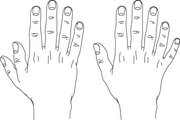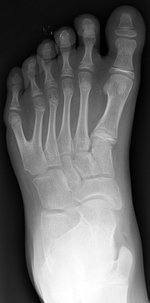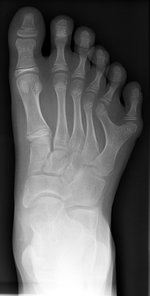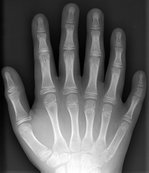Polydactyly
Polydactyly, or polydactylism, also known as hyperdactyly, is the anatomical abnormality of having more than the usual number of digits on the hands and/or feet. It is a congenital abnormality, usually genetically inherited as an autosomal dominant trait. more...
Overview
In humans, it is usual to have five digits (four fingers and one thumb) on each hand, and five digits (toes) on each foot. Polydactyls have six or maybe even more digits on either their hands or feet, or both. The extra digits vary from small pieces of soft tissue to apparently complete digits. In Western societies, they are usually surgically removed during early life.
The condition is reported in about 1 child in every 500, although the frequency varies greatly from population to population. It is higher in some groups (e.g. the Amish in the United States) due to the founder effect.
Historically and in the contemporary world, polydactylyism has been associated with witchcraft, psychic power, the extraterrestrial, divine connection, and sporting prowess.
Types of polydactyly
There are several types of polydactyly, of varying frequency. Here are some of them:
- Polydactyly alopecia seborrheic dermatitis
- Polydactyly with cleft lip/palate and psychomotor retardation (Varadi-Papp Syndrome)
- Polydactyly myopia syndrome
- Polydactyly postaxial dental and vertebral
- Polydactyly postaxial with median cleft of upper lip
- Polydactyly postaxial
- Polydactyly preaxial type 1
- Polydactyly syndrome middle ray duplication
- Polydactyly visceral anomalies cleft lip palate
Read more at Wikipedia.org






